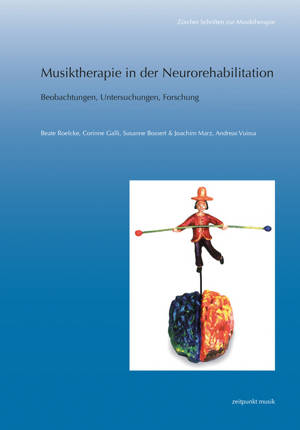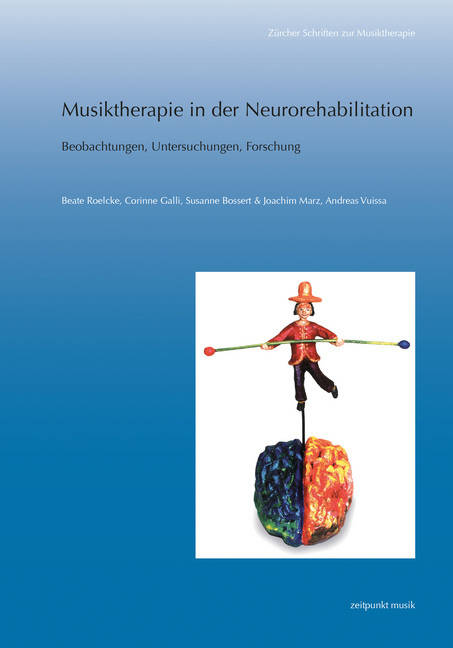
- Retrait gratuit dans votre magasin Club
- 7.000.000 titres dans notre catalogue
- Payer en toute sécurité
- Toujours un magasin près de chez vous
- Retrait gratuit dans votre magasin Club
- 7.000.000 titres dans notre catalogue
- Payer en toute sécurité
- Toujours un magasin près de chez vous
Musiktherapie in Der Neurorehabilitation
Beobachtungen, Untersuchungen, Forschung
Beate Roelcke, Susanne Bossert, Joachim Marz, Corinne Galli, Andreas Vuissa
31,45 €
+ 62 points
Description
English summary: Volume 6 of the Zurcher Schriften consists of four revised investigations from the practical field of neurorehabilitation, which were carried out at the Zurich University of the Arts. The topics of the first and second part of the book by Corinne Galli and Beate Roelcke refer to neurologically severely affected people after a stroke. Galli presents a quantitative study of contact and compares elements of a verbal therapy procedure with non-verbal ones of music therapy. Roelcke uses a setting for working with patients with neglectsyndrome to show music therapy procedures that are in the area of conflict between functional and psychodynamic aspects. The instruments developed by Joachim Marz, the treatment monochord and the kotamo, form the brackets of the third and fourth parts of the book. Andreas Vuissa examines the effect of a standardized relaxation method using Kotamo on people suffering from multiple sclerosis. Susanne Bossert & Joachim Marz are conducting a randomized and controlled study with the treatment monochord in people after accidental craniocerebral injuries. The enumeration of the diagnosis groups described in the book shows the wide spectrum of diseases from which patients of neurorehabilitation suffer. Suddenly occurring brain injuries are next to slowly occurring chronic changes due to inflammatory processes in certain brain regions with their specific symptomatology. Both have drastic consequences for the way we live and place high demands on the patients' processing capacity. The approaches of music therapy are correspondingly broad: music therapy methods and interventions are used from music-supported work with functional goals to psychodynamic support in disease processing, from the practicing level to the experience- and conflict-centered modality. The musical basis and the therapeutic relationship based on it form the common ground for all differences in the structure and outcome of the investigations. With the aim of caring for patients in the best possible way, optimizing forms of treatment and contributing to the proof of effectiveness of music therapy on a quantitative and qualitative level, the investigations were adapted and carried out according to the clientele and clinical conditions. The present book is an invitation to think and research further in this rapidly developing field of work. Music therapy has the potential to take on a unique and irreplaceable task. German description: Der 6. Band der Zurcher Schriften besteht aus vier uberarbeiteten Untersuchungen aus dem Praxisfeld der Neurorehabilitation, die an der Zurcher Hochschule der Kunste durchgefuhrt wurden. Die Themen des ersten und zweiten Buchteils von Corinne Galli und Beate Roelcke beziehen sich auf neurologisch schwerbetroffene Menschen nach Schlaganfall. Galli stellt eine quantitative Studie zur Kontaktaufnahme vor und vergleicht Elemente eines verbalen Therapieverfahrens mit nonverbalen der Musiktherapie. Roelcke zeigt in einem Untersuchungsaufbau aus quantiativen und qualitativen Anteilen anhand eines Settings zur Arbeit mit Patienten mit Neglectsyndrom musiktherapeutische Vorgehensweisen auf, die im Spannungsfeld von funktionalen und psychodynamischen Aspekten stehen. Die Klammer des dritten und vierten Buchteils bilden die von Joachim Marz entwickelten Instrumente Behandlungsmonochord und Kotamo. Andreas Vuissa untersucht die Wirkung eines standartisierten Entspannungsverfahrens mit Einsatz des Kotamo bei Menschen, die an Multipler Sklerose erkrankt sind. Susanne Bossert & Joachim Marz fuhren mit Hilfe des Behandlungsmonochords eine randomisierte und kontrollierte Studie mit Menschen nach unfallbedingten Schadel-Hirnverletzungen durch. Die Aufzahlung der im Buch beschriebenen Diagnosegruppen zeigt das weite Spektrum an Erkrankungsformen unter welchen Patienten der Neurorehabilitation leiden. Plotzlich eingetretene Hirnverletzungen stehen neben langsam auftretenden, chronischen Veranderungen aufgrund entzundlicher Prozesse in bestimmten Hirnregionen mit der jeweils spezifischen Symptomatik. Beides bringt einschneidende Folgen fur die Lebensgestaltung mit sich und stellt hohe Anforderungen an die Verarbeitungskapazitat der Patienten. Dementsprechend breit sind auch die Vorgehensweisen der Musiktherapie: Musiktherapeutische Methoden und Interventionen werden vom musikunterstutzten Arbeiten mit funktionalen Zielen bis zum psychodynamischen Begleiten in der Krankheitsverarbeitung, von der ubenden Ebene bis zur erlebnis- und konfliktzentrierten Modalitat eingesetzt. Die musikalische Grundlage und die darauf aufbauende therapeutische Beziehung bilden bei allen Unterschieden im Aufbau und Outcome der Untersuchungen die gemeinsame Grundlage. Mit dem Ziel Patienten auf die bestmogliche Weise zu betreuen, Behandlungsformen zu optimieren und auf quantitativer und qualitativer Ebene einen Beitrag zum Wirksamkeitsnachweis der Musiktherapie zu leisten sind die Untersuchungen dem Klientel und den klinischen Bedingungen angepasst und durchgefuhrt worden. Das vorliegende Buch versteht sich als Einladung zum Weiterdenken und Weiterforschen in diesem sich rasant entwickelnden Arbeitsfeld. Die Musiktherapie hat das Potential, darin eine einzigartige und unersetzbare Aufgabe zu ubernehmen.
Spécifications
Parties prenantes
- Auteur(s) :
- Editeur:
Contenu
- Nombre de pages :
- 262
- Langue:
- Allemand
- Collection :
Caractéristiques
- EAN:
- 9783954904747
- Date de parution :
- 23-09-20
- Format:
- Livre broché
- Format numérique:
- Trade paperback (VS)
- Dimensions :
- 173 mm x 18 mm
- Poids :
- 498 g







